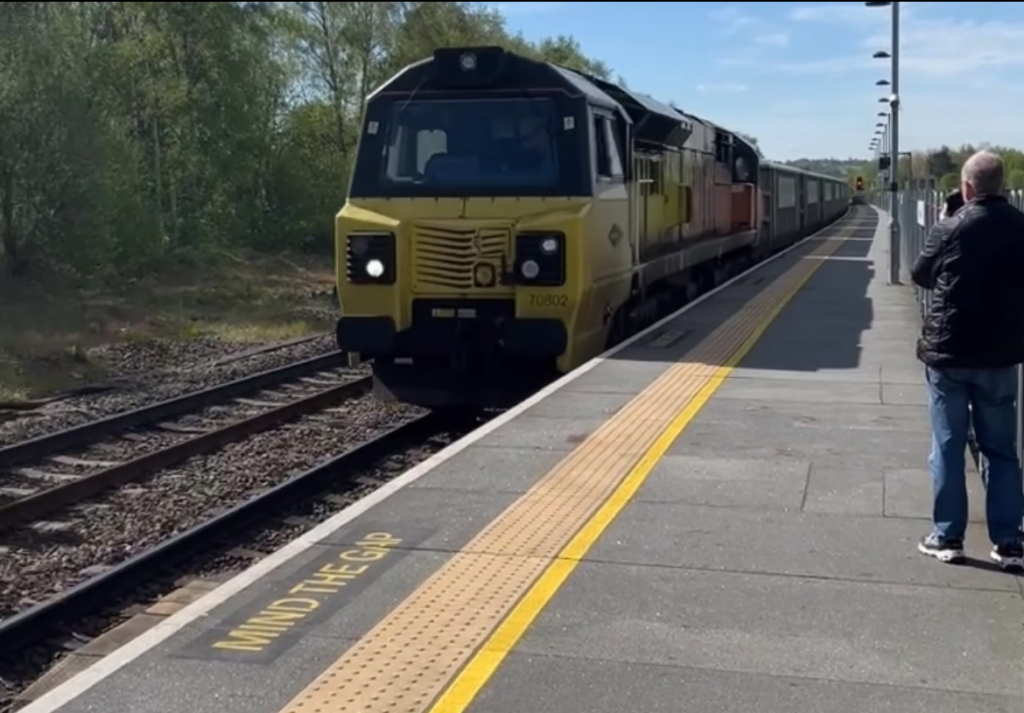Post Written by Matthew Walters

Hello Readers,
Here I am writing this month’s Traction Blog. Last month, I wrote about my experience in April, and I explained what it’s like to pursue train spotting as a hobby. This time, I will continue to do so, while also talking about my various trips between May and June.
How we record train numbers
In the first blog, I didn’t mention what Rail Enthusiasts use to collect train numbers. Various publishers create a logbook of all the current rolling stock on the British rail network each year. I use the “British Railways Locomotives & Coaching Stock” volumes from Platform 5 Publishing Ltd and I highlight the numbers I have seen with a highlighter pen. My current edition is from 2021 so it isn’t fully up to date but most numbers that currently exist in 2024 are in this book. Whatever book you decide to use comes down to personal preference, I can recommend either this for a detailed book, or for a simpler book that’s straight to the point, there is the “Spotter’s Companion”

British Railways Locomotives & Coaching Stock
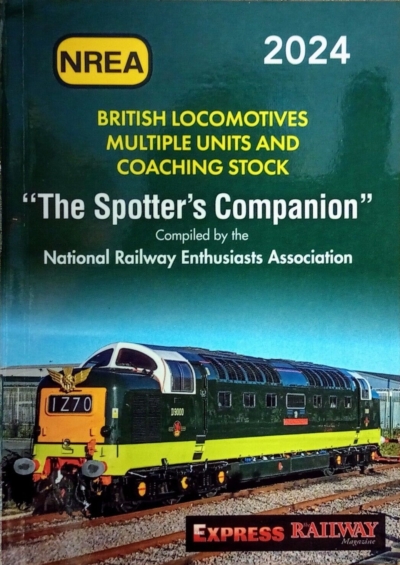
The Spotter’s Companion
Chesterfield Railway Station: May 2024
Firstly, I visited Chesterfield Station, with Penistone Line Partnership’s deputy chair, Glyn, and his brother Ros. We grouped up at Meadowhall Station and caught the 10:23 Northern Service to Nottingham. The journey time was 28 Minutes as we called at Sheffield & Dronfield on route to Chesterfield.
Chesterfield is on the Midland Main Line between Sheffield and London St Pancras, which currently isn’t electrified, meaning only diesel traffic runs through the station, which includes:
- Diesel Locomotives
- DMUs (Diesel Multiple Units)
- Network Rail Engineering Vehicles
Chesterfield sees plenty of passenger and freight traffic, due to this section of the Midland Mainline being shared by a vital freight route, which joins at a junction north of the station. Due to this, quite a few interesting locomotives had been sighted, which I photographed and filmed for this blog post.
Chesterfield Station is managed by East Midlands Railway, who have all their rail services stop here. Stock from EMR’s fleet that call here are:
- Class 158s on the Liverpool Lime Street – Nottingham /Norwich service
- Class 222s on the Sheffield – London St Pancras service.

(EMR DMU 222005 to Sheffield)
Other Train Operating Companies (TOCs) that call at Chesterfield are Northern with their Class 195s on the Leeds – Nottingham service.
CrossCountry operate direct services with Class 220s and 221s as far as:
- Glasgow
- Edinburgh
- Plymouth
However, not all CrossCountry’s services stop at this station.
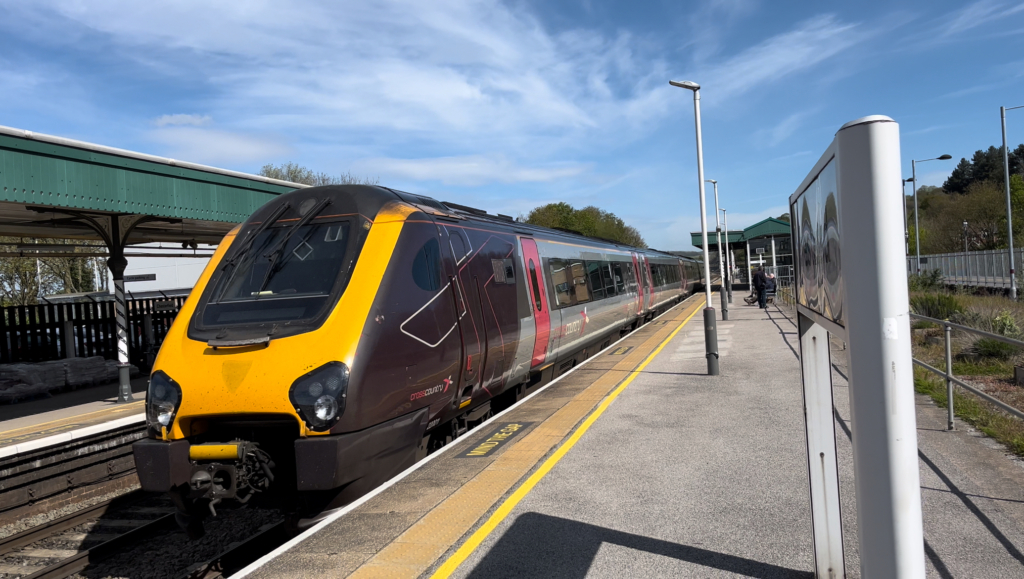
(XC DMU 220011 to Plymouth)
Freight Trains at Chesterfield: May 2024
For trainspotters, freight trains are a lottery, we don’t know what locomotive will be pulling the train, or what cargo is being hauled until the train passes us. We also don’t know what times they will come, as passenger services are prioritised on the British Rail Network, often delaying freight trains as they must let passenger services pass them. It was very surprising to see Rail Operations Group’s 37800 hauling two of West Midlands Railway’s new Class 730 Units, which were being delivered to them after being painted in their liveries (they’ve pinched PLP’s new branding colours).
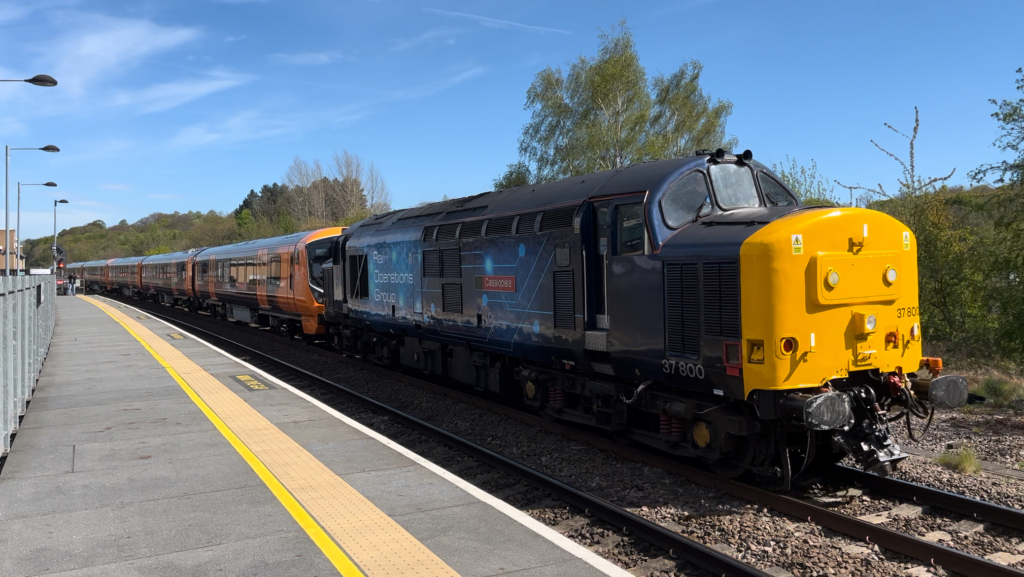
(37800 Hauling 730036 & 730038)

Class 37
The oldest locomotives still in regular service in Britain are the Class 37s, with them being built between 1960-65. Only 66 of the 309 built still operate today, as the majority have either been scrapped, preserved or are in storage, with 3 being sighted during our time at Chesterfield. They were the previously mentioned 37800, and two more which formed a Network Rail Track Inspection train, numbered 37219 & 37607 respectively.
The train was halted at Platform 3 for over half an hour, as it had to wait for several passenger services to pass on other lines.
Each of the coaches have their own number, so for this type of train collecting the coach numbers are a necessity, as those are logged into the overall books too.
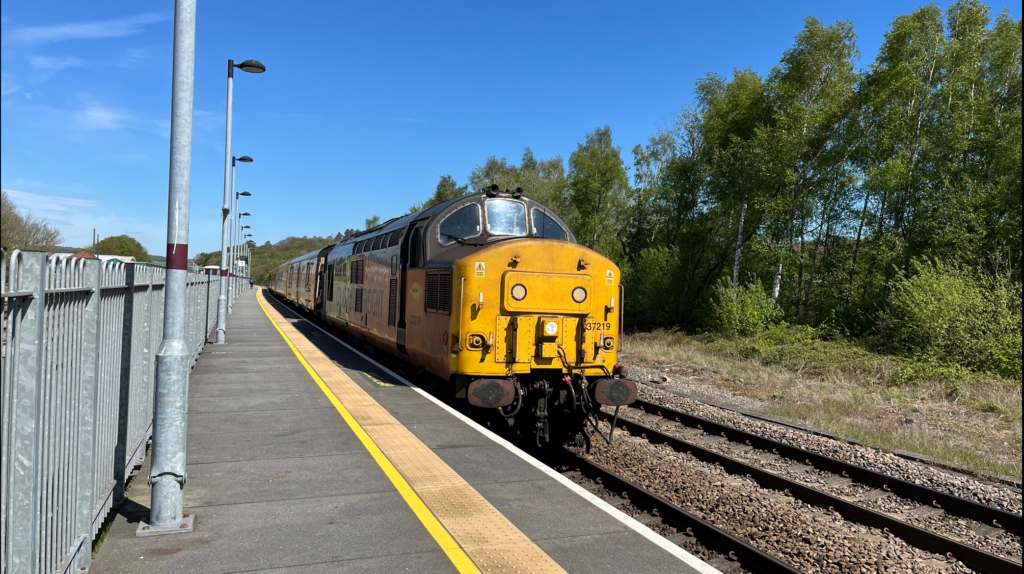
Class 66
In my last blog post I mentioned the most common Diesel Freight Loco’s on the network are the Class 66s, with 480 built in total. Various freight companies ran their stock through the station on this day, including:
- Freightliner:
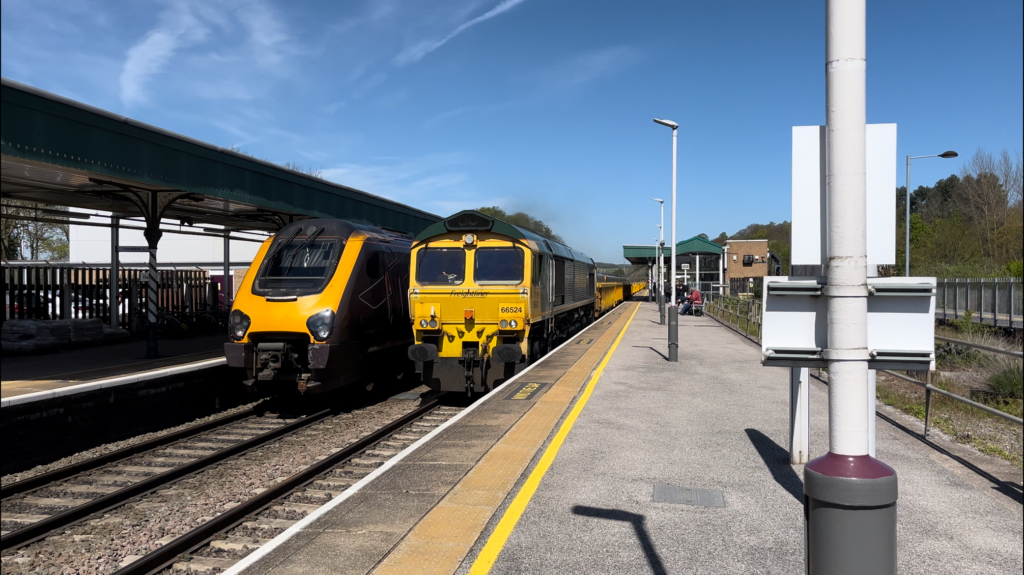
(66524 Hauling Ballast)

(66504 at the tail end of the ballast train)
- GB Railfreight:

(66704 Hauling Network Rail Engineering Equipment)
- & DB Cargo UK:

(66169 retaining its original EWS Livery)

(66177 Hauling a container train)
The Class 66s we saw pulled different loads of cargo, including containers, Network Rail Engineering equipment and ballast, with 6 being sighted during our time there.
Class 69
The Class 69s are a group of 16 locomotives which were withdrawn Class 56s that were rebuilt between 2020-24, which are all operated by GB Railfreight. 69001, the first rebuilt locomotive, passed us on Platform 3.


Class 70
The last loco type to pass through Chesterfield during our time there was 70802, which is operated by Colas Rail Freight and was hauling a LAND RECOVERY LTD Aggregate Train. PLP’s community rail officer would like to organise a careers trip to their port location at Dewsbury.
NR Tamper
At Chesterfield, one of Network Rail’s Tamper units sits outside the station in a siding. Here is a photo I took of it passing Platform 1 into the siding junction.
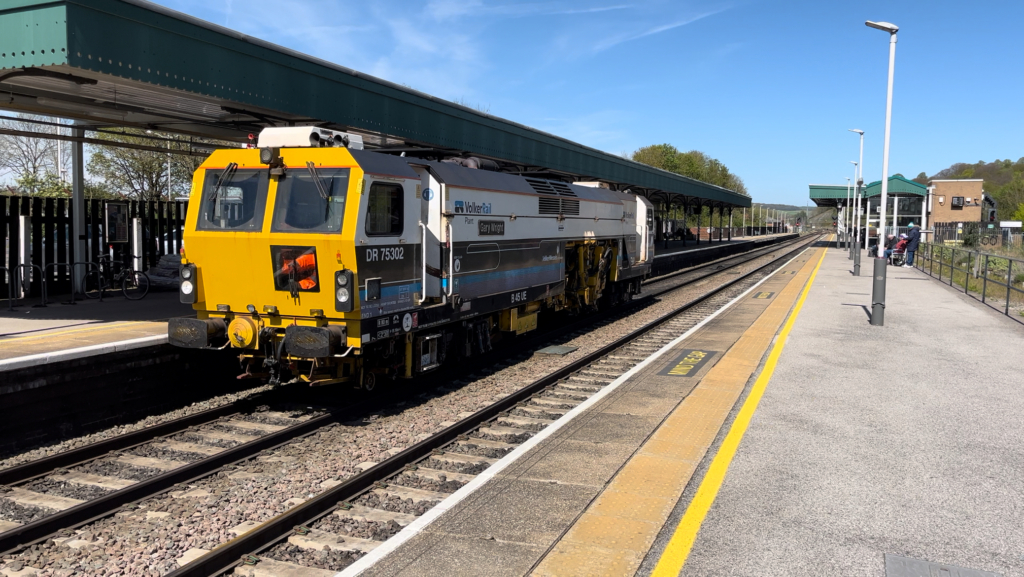
(DR75302 “Gary Wright” Pulling into the siding junction at platform 1)
After catching the 14:21 Northern Service to Leeds, we alighted off the train at Meadowhall.
One of the huge appeals of the hobby is searching for freight locomotives, as there are so many different types, whether built recently or decades ago, there are so many locos to locate and log into your collection of sightings.
Leeds & Doncaster Round Trip: May 2024
Ros and I boarded the 09:24 Northern Service to Leeds at Meadowhall once again, and arrived at Leeds at 10:14, so around a 50 minute journey time.
Leeds is the busiest Railway Station in the north of England, seeing on average over 23.9 million passengers using the station (2022/3). The Station boasts 17 Platforms and at least 46 trains call there every hour! Leeds is the terminus station of the Leeds branch of the East Coast Mainline, it’s electrified, and it isn’t on any freight routes, meaning the traffic that passes through are:
- Electric Multiple Units (EMUs)
- Diesel Multiple Units (DMUs)
Services here include those by London North Eastern Railway, CrossCountry, Trans-Pennine Express and Northern. LNER operates 2 services an hour to London Kings Cross on the East Coast Main Line, and still use some of their InterCity 225 Class 91 units that entered service between 1988-91. LNER have repainted their fleet (that aren’t in storage) into the iconic InterCity livery, but with their logo instead, and colored in oxblood, red, grey and white instead of the classic InterCity branding.

(91106 bound for London Kings Cross)
LNER also run their modern Azuma fleet into Leeds, providing regular services to London Kings Cross, as well as 1 train per day to:
- Harrogate
- Skipton
- Aberdeen
- 2 trains a day to Bradford Forster Square.

(LNER Azuma 800107)
With Leeds seeing 46 trains an hour, it is often that trains pass each other several times outside the station entrance.
CrossCountry run their fleet of Voyagers through the station, providing 1 train per hour North to Edinburgh and South to Plymouth.

(195013 [LEFT] & 220002 [RIGHT])
- Manchester
- Saltburn
- Hull
- Liverpool
- 8 trains a day to Scarborough.

(185131 & 185133)
And finally, Northern run the most services to and from Leeds, using various classes of DMUs and EMUs, including
- 150s, 155s, 158s
- 170s
- 195s, 331s
- 333s
to various towns and cities, including Lincoln, Nottingham, Sheffield, Barnsley, Rotherham, Doncaster, Skipton & Ilkley to name a few.

(Northern’s Class 331 [LEFT] & Class 333 [RIGHT] EMUs)
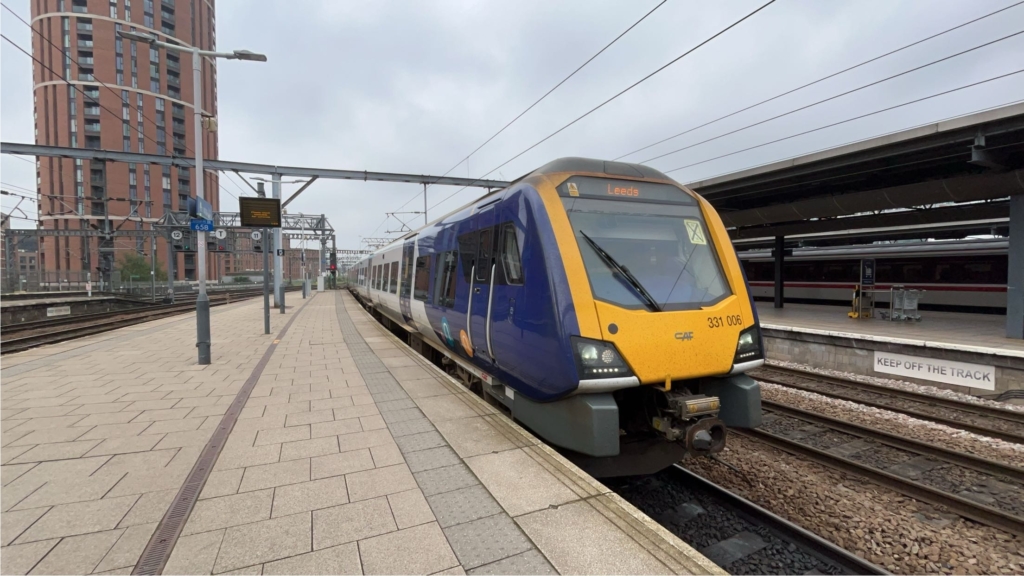
(331006)
After boarding the 12:21 Northern Service to Doncaster, we arrived at 13:06, where we saw some more trains in the following videos:
Ruswarp & Whitby Lineside Walk: June 2024
To conclude this edition of the Traction Blog, here is a video of 158853 passing the Level Crossing at Ruswarp Station, near the picturesque seaside town of Whitby. The line is single track, but used to be a double track line, and where the 2nd track used to be is now a footpath for walkers to walk lineside (BEHIND A FENCE) between Whitby & Ruswarp Stations. On my walk back I also caught a video of North Yorkshire Moors Railway’s preserved Class 25 Diesel (BEHIND A FENCE) passing through with a service from Pickering to Whitby. The clip below shows both of these videos edited together.
Overall, I have had some positive experiences pursuing trainspotting as a hobby across the last 2 months. I went to many different places across Yorkshire and Derbyshire to collect memories and stories to share for this month’s blog. I really hope that this blog is helping you learn about what it’s like to be a rail enthusiast, and next month I am hoping to explore more stations across the network in other counties besides Yorkshire, to make sure the blog isn’t repetitive. I hope you enjoyed reading this post, the next post will be in July, when I will hopefully be able to share more experiences.
Matthew 😊


